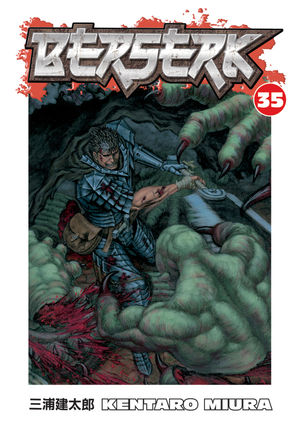Dark Horse comics continues to support my type of manga as Berserk collection 35 hits the United States. While the series is a little further according to my research, it looks like it'll be some time before volume 36 hits the streets.
When I read Berserk, the high energy of Miura's art inspires me. For me, his style is similar to another favorite of mine on the Super Hero comics shores, George Perez. It has a ton of detail and a lot of movement to it.
In this volume, we see further ramifications of past events continue to unfold. This provides some good ground work for those who run episodic adventures with an other all theme or arc. In this instance, Guts efforts to save Caska by taking her to the isle of the fey comes under complication when a pirate ship falls pray to the new madness and in turn becomes an enormous threat. In D&D 3rd edition, this could easily be done through the addition of templates, class levels, or other such goods. In other versions of the game, depending on how serious the GM is taking it, he might just rewrite the material and hand wave the reasoning.
In addition, since the ship takes some damage in their battle with the monster ship, the group is forced to make landfall on an island.
Islands are great bits for fantasy games for several reasons.
1. They can be isolated. This allows the GM to throw in things that are older than the standard setting in terms of dress, eating, religion, weapons, attitudes and outlook.
2. They can be isolated physically. Sure, the weird natives might be giving off a Wicker Man vibe and setting up all sorts of unpleasant events, but the real problem is that there's no damn way off an island outside of repairing the wreck you came in.
Movies like Cast Away or television shows like Lost showcase some of the other problems with an island. Equipment may be hard to come by for example. Isolation from the mainland may cause strange mental illness to forment on those isolated too long.
But in a fantasy game, there could be other issues.
For one, the island itself could be alive.
For another, the island could be slowly moving through the planes.
For another, the island could be at a center of power that attracts all sorts of weirdness to it as individuals try to harness this energy in ritualistic manner.
Another useful thing about islands, is that if you're not making them a continuous stop or part of the setting, it's not that big a deal to wipe out the inhabitants to showcase how vile a particular monster is. In this case, the creature that's coming after Guts and his party has destroyed the village and absorbed them, making them new monsters that come against the party.
Another thing to note about islands though, in all this talk of flesh eating and isolation, is that they make a good point in a sea campaign to introduce new players. In this instance, Isma, a native to the island whose mother is supposedly a mermaid and whose life is outside the town, showcases how to introduce a new character that has reason to trust the party (isolated from the other inhabitants of the island) and is full of the desire to explore and leave the small town behind. It works well in this instance and provides more fuel for the unusual side of the Berserk saga.
Berserk 35 isn't going to bring in any new fans to the series but it doesn't disappoint the old fans. The kinetic art and action provide a lot of fodder for the imagination and the new character brings more complications to the young 'ens of the cast.
Subscribe to:
Post Comments (Atom)






Big Berserk fan here myself. I found the art file book for one of the PS2 Berserk games - gorgeous, and with little fanfare could be made into RPG material. I have to say you are lucky reading it in English - the Japanese is quite the challenge.
ReplyDelete